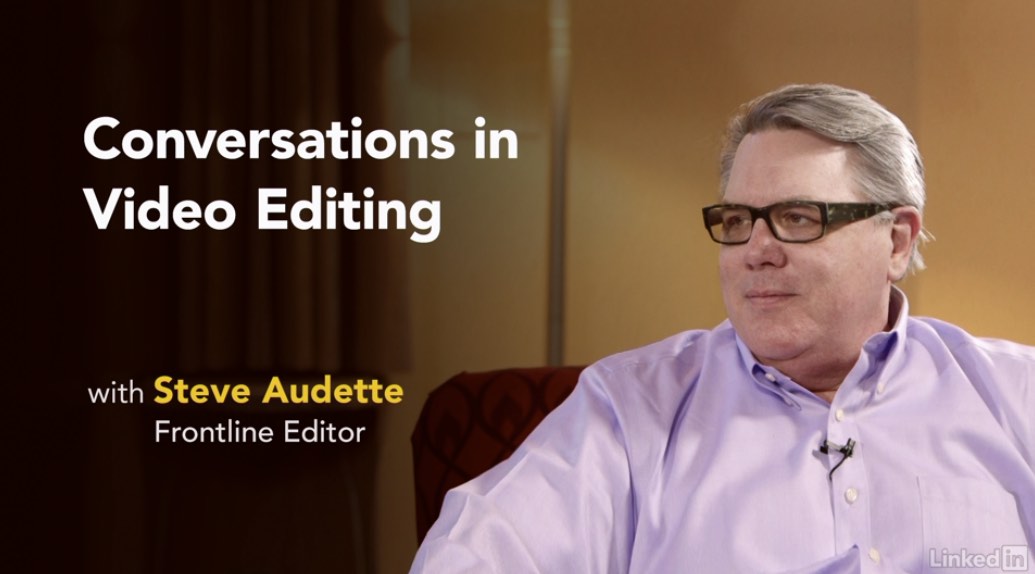A Documentary Editing Masterclass
If you’re new to the world of documentary editing then this hour long conversation with 22 year veteran Frontline editor Steve Audette, will serve as masterclass in documentary editing. It’s a rare opportunity to get inside the world and mind of editor who tells truthful stories in a dramatic and compelling way.
I really think that the foundation of any experience of a film or television programme is based on the soundtrack, and that sound design that goes into it. Because sound is the only really 3D element, the only truly 3d element of any film… What happens with sound is that it enters the room and creates an environment that affects you, all around you. And so I believe if the sound design is done well you can bring the subconscious from the couch, across the room, beyond the screen and into the world of the film. And it’s only sound can do that translation.
Steve covers a lot of ground in this interview, which you can also check out in full over on Lynda.com, which whether or not you’ve got an account, is worth doing if you want to read through a full transcript of the interview (for free) if you’d rather read your way through this treasure trove.
If you like what Steve has to say then you absolutely must check out these previous posts that have a ton of great resources from Steve who is a very generous editor in how open he is with sharing his skills, experience and philosophy with the rest of us.
How To Edit A Documentary | Inside a Professional Edit Suite | An Exemplary Lecture on Editing Documentaries
Also Natalie from Mentorless.com has drawn out 10 lessons from the ‘Lecture on Editing Documentaries‘ which is worth a quick read, to get a jump start on the content.
If you make it about a character traveling through a larger story, then anything that character doesn’t know, your audience will forgive you for.
From the @frontlinepbs Edit room #TimelineTuesday #postchat @Avid @MediaComposer #documentary pic.twitter.com/UV3Rg3nvlU
— Steve Audette, ACE (@stevecutsdocs) April 21, 2015
No doubt making some "pointed" observation during my #documentary seminar. @Avid @MediaComposer @FMCTraining pic.twitter.com/WRrIyLU3jF
— Steve Audette, ACE (@stevecutsdocs) April 17, 2015
Crafting A Documentary
Although crafting a documentary is to some degree largely a post-production process – what you tell and don’t tell, how you tell it and why – you’ve got to have the footage in the first place. In these short 4 minutes you get a good sense of Frontline’s production process from producer/director Michael Kirk.
Editor Sam Pollard shares some sage advice on working with music early on in the editorial process. He references Ralph Rosenblum’s book – When the Shooting Stops… the Cutting Begins, which I’ve previously reviewed here.
In this excellent LACPUG talk editor Doug Blush ACE shares some stories from the trenches of his editorial career which has spanned over 40 feature documentaries. He shares some clips and answers audience questions in this great talk that’s well worth a watch.
Editor and Director Zack Arnold shares some insights on the production of his feature documentary, Go Far, at the Boston Creative Pro User Group. It’s an inspirational account of how a great story simply must be told, if you have the tenacity to do so.
There’s a nice write up on the making of the BAFTA winning Senna, a documentary directed by Asif Kapardia and edited by Chris King and Gregers Sall, over on realscreen.com.
Kapadia adds that “not only was there U-matic, one-inch, Super 8 and 35 mm, but we also had audio tapes – TDK A90s recorded in the mid-’80s – where journalists had interviewed someone. And we looked at the video [and thought], ‘Well, who’s holding that cassette player? Let’s see if we can go and find her and see if she’s still got her tape in the attic somewhere.’”
Such rare audio features in one crucial scene, in which Senna talks passionately about what driving means to him. Researchers managed to track down a journalist who had interviewed the driver more than a decade ago, only to be told that said journo had since recorded over the original tape. The team was crestfallen.
“But luckily, we were editing for so long that six months later he rang up and said, ‘I’ve found it in another house, somewhere else!’ And we were able to put it in,” says Kapadia. “With any other job, the film would’ve been completed by then, but we were not even locked. So we were able to use it. That was a great part of this process – having time.”
UPDATE
https://www.youtube.com/watch?v=YHA8747Zpo8
In this seven minute BAFTA mini-masterclass you can hear from Gregers Stall himself, on the challenges of crafting Senna. HT to @insidetheedit for the link!
Lastly, this timelapse of a documentary edit in FCPX demonstrates just how much work goes into whittling down a long project into a finished film. Nice to see FCPX at work!





